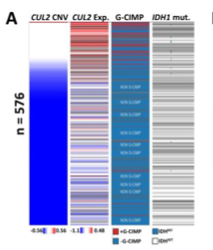A functional artificial neural network for noninvasive pretreatment evaluation of glioblastoma patients.
Zander E, Ardeleanu A, Singleton R, Bede B, Wu Y, & Zheng S. A functional artificial neural network for noninvasive pretreatment evaluation of glioblastoma patients. Neuro-Oncology Advances (2021)
How they used Xena
They used Xena’s Visual Spreadsheet to construct part of Figure 1, where they examined CUL2 expression and copy number variation, as well as downloading data from Xena for other analyses.

Portion of Figure 1 looking at CUL2 expression and CNV in Xena’s Visual Spreadsheet
Join the conversation on Twitter about this publication
Paper
Background
Pretreatment assessments for glioblastoma (GBM) patients, especially elderly or frail patients, are critical for treatment planning. However, genetic profiling with intracranial biopsy carries a significant risk of permanent morbidity. We previously demonstrated that the CUL2 gene, encoding the scaffold cullin2 protein in the cullin2-RING E3 ligase (CRL2), can predict GBM radiosensitivity and prognosis. CUL2 expression levels are closely regulated with its copy number variations (CNVs). This study aims to develop artificial neural networks (ANNs) for pretreatment evaluation of GBM patients with inputs obtainable without intracranial surgical biopsies.
Methods
Public datasets including Ivy-GAP, The Cancer Genome Atlas Glioblastoma (TCGA-GBM), the Chinese Glioma Genome Atlas (CGGA) were used for training and testing of the ANNs. T1 images from corresponding cases were studied using automated segmentation for features of heterogeneity and tumor edge contouring. A ratio comparing the surface area of tumor borders vs. the total volume (SvV) was derived from the DICOM-SEG conversions of segmented tumors. The edges of these borders were detected using the canny edge detector. Packages including Keras, Pytorch, and TensorFlow were tested to build the ANNs. A 4-layered ANN (8-8-8-2) with a binary output was built with optimal performance after extensive testing.
Results
The 4-layered deep learning ANN can identify a GBM patient’s overall survival (OS) cohort with 80-85% accuracy. The ANN requires 4 inputs, including CUL2 copy number, patients’ age at GBM diagnosis, Karnofsky Performance Scale (KPS), and SvV ratio.
Conclusion
Quantifiable image features can significantly improve the ability of ANNs to identify a GBM patients’ survival cohort. Features such as clinical measures, genetic data, and image data, can be integrated into a single ANN for GBM pretreatment evaluation.